15 years one-stop China custom CNC machining parts factory
 428 |
Published by VMT at Apr 17 2025 | Reading Time:About 5 minutes
428 |
Published by VMT at Apr 17 2025 | Reading Time:About 5 minutes
Bending stainless steel tube can seem like a daunting task, especially if you're not familiar with the challenges and processes involved. The unique properties of stainless steel make it both a durable and versatile material, but bending it requires careful consideration of factors like thickness, bend radius, and method of bending. If you’re facing a project that involves stainless steel tube bending, understanding the best techniques and tools is crucial. This guide will walk you through the basics and help you decide on the best method for your needs.
Bending stainless steel tube requires careful planning and the right equipment. The ideal method depends on the tube's diameter, material thickness, and the specific application. Solutions like mandrel bending, rotary stretch bending, and heat induction bending offer precise results with minimal distortion.
Now that we’ve covered the basics, let's explore the different techniques used for bending stainless steel tube, and examine the preparation steps required for successful bending.
Stainless steel is favored in a wide range of industries due to its corrosion resistance, strength, and aesthetic appeal. However, bending stainless steel tubing requires a combination of the right tools and expertise, as the material is both strong and stiff. Whether you’re working on automotive, aerospace, or construction applications, bending stainless steel tube is often a necessity to fit complex shapes or optimize design. However, due to its high tensile strength, stainless steel can present difficulties in bending without causing material failure or structural damage.
Unlike softer metals, stainless steel doesn't bend easily under pressure. If bent incorrectly, it can cause cracks, kinks, or weakening in the material. Because of this, it's essential to understand the specific properties of stainless steel and use the appropriate techniques to ensure smooth, accurate bends. Choosing the wrong bending method can lead to costly errors, production delays, and compromised structural integrity.
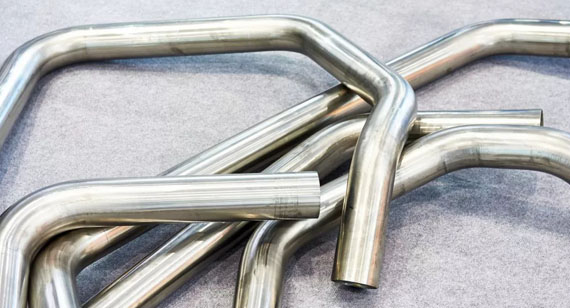
Bending stainless steel tube is not as simple as bending softer materials like aluminum. Stainless steel has a high yield strength, meaning it requires more force to deform. Additionally, stainless steel’s work-hardening property causes it to become even harder as it is bent, making it more resistant to further shaping. Because of this, accurate calculations are crucial when determining the bend radius and material thickness to avoid cracking or warping during the process.
One challenge when bending stainless steel tube is maintaining the internal structure of the tube. If not supported properly, the inside of the tube may collapse or wrinkle. To prevent this, methods like mandrel bending or using external supports are often employed. Additionally, factors such as the tube’s weld seams, thickness, and whether it’s welded or seamless all influence the ease and quality of the bend.
When it comes to bending stainless steel tube, precision is everything. This process isn’t just about applying force to shape metal — it’s a calculated method that requires technical knowledge, the right equipment, and an understanding of material properties. Stainless steel is tough, resistant to deformation, and prone to work hardening, which makes bending it far more complex than softer metals like aluminum or copper. To achieve smooth, accurate bends without compromising the material’s integrity, manufacturers must use specialized bending techniques — especially in industries like aerospace, automotive, and medical device manufacturing where quality and consistency are critical.
Whether you’re a professional in CNC machining services or working on a custom fabrication project, understanding how to bend stainless steel pipe the right way can save time, reduce waste, and improve the final product’s performance. Below, we’ll walk you through key preparation steps and deep-dive into one of the most effective bending techniques: mandrel bending.
Preparation: The Key to Perfection
Before any bending takes place, proper preparation is essential. Neglecting this step can result in poor-quality bends, tube collapse, or material failure. The preparation stage sets the tone for the entire process and directly impacts bend accuracy, tool wear, and material waste.
Start by choosing the right type of stainless steel pipe — either welded or seamless — depending on the application. Seamless tubes tend to perform better under stress and are more resistant to cracking. Measure the pipe’s wall thickness, diameter, and material grade to determine the appropriate bending method and radius. Thicker walls may require higher bending force and better support to avoid flattening or wrinkling.
Next, inspect the surface of the stainless steel tube for imperfections or contaminants that could interfere with bending. Cleaning the surface helps prevent slippage during bending and improves the consistency of the bend. Then, mark the bending locations accurately and secure the pipe in the bending machine, ensuring alignment with the dies and supports.
Finally, double-check the machine settings — especially if using CNC prototype machining or other automated methods. Feeding speed, angle control, and pressure settings should all be tailored to the material’s properties. Proper preparation not only prevents bending defects but also extends the lifespan of your equipment.
Mandrel Bending
What is Mandrel Bending?
Mandrel bending is a high-precision tube bending method used to achieve smooth, wrinkle-free curves in stainless steel tubes. It’s particularly ideal for thin-walled or tight-radius bends where the risk of distortion or collapse is high. Unlike basic compression or roll bending, mandrel bending uses an internal support — the mandrel — to maintain the tube’s shape throughout the process.
This technique is highly effective in industries like automotive exhaust systems, medical equipment, and aerospace assemblies where the consistency of the inner diameter is essential. Mandrel bending minimizes wall thinning, eliminates kinking, and helps preserve the structural strength of the stainless steel pipe. When paired with stainless steel CNC machining, it ensures maximum precision and repeatability — even in complex geometries.
One of the key advantages of mandrel bending is that it allows for tighter bend radii without damaging the pipe’s integrity. It also delivers a superior finish, reducing the need for secondary machining or refinishing operations.
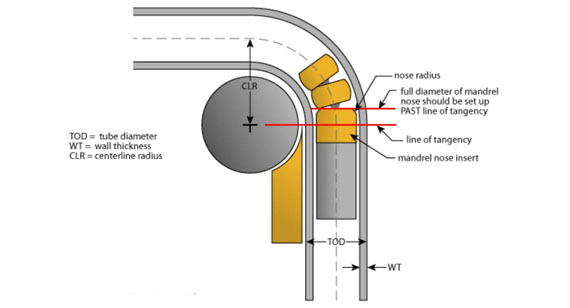
The Setup for Mandrel Tube Bending Includes:
Mandrel bending offers unmatched accuracy for stainless steel pipe bending and integrates seamlessly with CNC machining services for high-volume production. In the next section, we’ll explore additional bending techniques and how to choose the best one for your project.
Three-Roll Plate Bending Machine
The three-roll plate bending machine is one of the most traditional and widely used methods for bending large-diameter stainless steel pipes or sheets. It operates by sandwiching the pipe or plate between three rollers — two fixed lower rollers and one adjustable top roller. As the material passes through these rollers, it gradually curves to the desired radius.
This method is ideal for producing gentle curves and large-radius bends in thick stainless steel pipe. While it may not provide the tight precision of CNC or mandrel bending, it’s highly effective for projects where aesthetics or large cylindrical forms are the priority — such as in construction, architectural columns, or industrial tanks.
Despite being a manual or semi-automated method, it remains relevant due to its simplicity, low tooling costs, and ability to handle large materials. However, it requires experienced operators to achieve consistent results, and tight-radius or thin-wall bends may risk distortion.
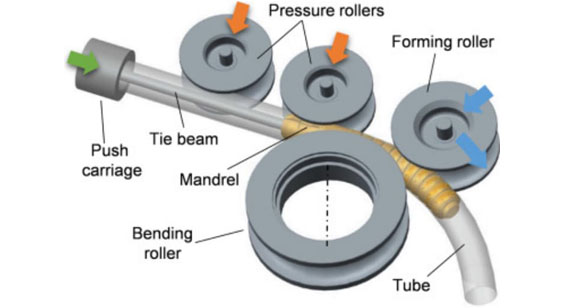
Stretch Bending
Stretch bending involves clamping both ends of a stainless steel tube and pulling it while simultaneously bending it over a die. The applied tension keeps the tube taut, minimizing wrinkling or flattening and ensuring a smooth, even bend.
This technique is widely used in aerospace and automotive industries where structural integrity and aerodynamic shapes are essential. Because the tube is under continuous tension, it’s easier to control the final shape and avoid springback — a common issue when bending stainless steel.
Stretch bending is best suited for parts that require long, sweeping curves. It’s more time-consuming compared to rotary bending or CNC-based methods, but the consistent tension ensures repeatability and improved bend quality. When combined with CNC prototype machining, it’s possible to produce complex parts in small batches with high accuracy.
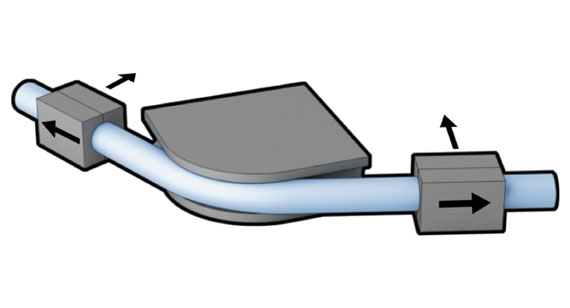
Compression Bending
Compression bending is a cost-effective method that involves clamping one end of the pipe while a compression die forces the free end around a stationary form. Unlike mandrel bending, there is no internal support, so it’s generally used for thicker-walled pipes or when precision is not the top priority.
This method is simple and effective, making it popular for low-cost production or less demanding applications. However, because there’s no internal mandrel, thin-walled stainless steel tubes may experience deformation, flattening, or wrinkling — especially when bent to tight radii.
For projects where aesthetics or inner diameter precision isn’t critical, compression bending offers an efficient way to shape stainless steel pipe. It's often used in handrails, furniture frames, and decorative metalwork. In more demanding applications, however, other stainless steel CNC machining solutions may provide better performance.

Rotary Stretch Bending
Rotary stretch bending combines rotation and tension to form highly accurate bends. In this method, the tube is clamped at both ends and stretched while being wrapped around a bending die. The stretching force keeps the tube under tension, which reduces springback and allows for high-precision bending.
This process is commonly used for aluminum and stainless steel in the aerospace and railway sectors, where large, curved components must retain structural strength. It works especially well on large, lightweight profiles that need complex curves without distortion.
Rotary stretch bending can be automated with CNC machining services to ensure consistent results across production runs. It offers high control, reduced tooling wear, and excellent repeatability, though it does require sophisticated equipment and setup time.

Roll Bending
Roll bending is ideal for creating cylindrical or conical curves in stainless steel pipe or sheet. It works by feeding the material between a set of rollers arranged in a triangle. As the rollers turn and adjust pressure, the pipe gradually bends into the desired curve.
This method excels at forming long-radius curves or large-diameter arcs. It’s widely used in construction, infrastructure, and architectural applications — for example, in structural beams or metal artwork installations. Roll bending is not ideal for tight bends or thin-walled tubes, as those may deform under pressure.
Roll bending machines are simple to operate and cost-effective for larger projects. While it’s not a precision-focused process like CNC bending, it offers a great solution when shape aesthetics and structural support are more important than dimensional accuracy.

Heat Induction Bending
Heat induction bending uses a coil to heat a specific area of the stainless steel tube, softening it so it can be bent with less force. The heated section is then pushed around a bending die while being cooled rapidly, typically with water spray, to retain the new shape.
This technique is ideal for bending large-diameter, thick-walled stainless steel pipe where mechanical bending might be insufficient. It’s commonly used in power plants, shipbuilding, and pipeline systems. The main advantage is that it reduces internal stress and prevents cracking — especially important when dealing with hard or high-grade stainless steels.
Heat induction bending provides smooth, clean bends with minimal deformation. However, the process requires precise temperature control and safety precautions to prevent material degradation. It’s best used in combination with stainless steel CNC machining to refine the final component after forming.
CNC Bending
CNC bending is the gold standard for modern tube bending operations, offering unmatched accuracy, repeatability, and speed. Using automated machines controlled by computer software, CNC bending can produce complex, multi-angle bends in stainless steel pipe with minimal human intervention.
This technique is ideal for mass production or high-precision components required in medical devices, aerospace, automotive, and electronics. CNC bending ensures perfect alignment, consistent angles, and excellent surface finish — even for the most intricate designs.
With CNC prototype machining, manufacturers can test and refine designs before moving into full production, saving both time and costs. Whether for short-run prototyping or large-scale manufacturing, CNC bending is a core capability of today’s advanced CNC machining services.
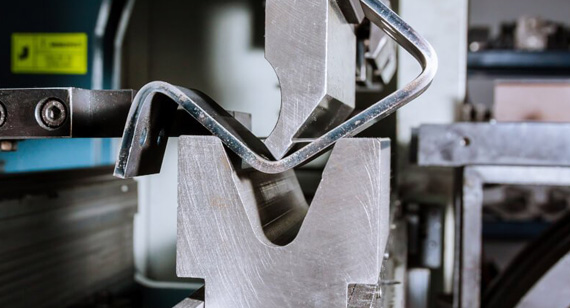
Bending stainless steel tubes is not as simple as just applying force and hoping for the best. Various factors must be taken into account to ensure that the bent pipe retains its structural integrity and meets the desired specifications. These factors include the bend radius, yield strength, material thickness, and the choice between welded tube vs. seamless tube. Understanding these elements is key to achieving a high-quality bend while avoiding issues like warping, cracking, or compromising the tube’s strength.
Bend Radius
The bend radius refers to the minimum radius that a tube can be bent without affecting its strength or structural integrity. This radius is crucial because a tight bend can cause the stainless steel to stretch on the outside and compress on the inside, potentially leading to fractures or deformation. The bend radius is typically expressed in terms of the tube’s diameter (D), with common standards being 2D for standard bends and up to 7D for tighter bends. It is essential to ensure that the chosen radius falls within the material’s bending limits to avoid unnecessary damage. The tighter the bend, the greater the risk of material failure, so determining the optimal bend radius is essential when planning your project.
When performing bending stainless steel pipe, it’s important to account for this radius based on the stainless steel's specific alloy, as some grades may require a larger bend radius. Achieving this bend correctly requires precision, which is why CNC prototype machining is frequently employed in projects demanding accuracy.
Yield Strength
The yield strength of stainless steel refers to the amount of stress the material can withstand before it begins to permanently deform. Stainless steel grades vary in yield strength, with some, like 304, having a relatively lower yield strength, while others, like 316, offer higher strength and resistance to deformation.
The yield strength is an important factor in bending because if the stress applied during the bending process exceeds the material’s yield strength, the tube will be permanently deformed or even crack. To avoid this, it's crucial to understand the material’s specifications and select the appropriate bending process. For bending stainless steel tube with higher yield strength, techniques like mandrel bending or heat induction bending can be particularly effective as they reduce stress on the material during the process.
Material Thickness
The material thickness plays a vital role in the bending process. Thicker stainless steel tubes are more resistant to deformation, but they also require greater force and more time to bend. On the other hand, thinner tubes are more susceptible to wrinkling, collapsing, or flattening when subjected to bending, especially when tight bends are involved.
It’s essential to adjust your bending process to accommodate the thickness of the material. For thicker tubes, you might use CNC bending services or heat induction bending, which can handle higher force without causing damage. On the other hand, for thinner tubes, ensuring proper tooling and clamping force is essential to avoid unwanted deformation.
Welded Tube vs. Seamless Tube
When selecting the type of tube for bending, it’s also important to consider whether the tube is welded or seamless. Welded tubes are formed by welding together two edges of a flat sheet of stainless steel, while seamless tubes are created from a single piece of material, with no welding involved.
Seamless tubes are typically stronger and more reliable for bending, as they do not have a welded seam that could fail under stress. Welded tubes, however, are more cost-effective and can still perform well when the bends are not as tight or the material thickness is sufficient to withstand the bending process. The key is to understand the limitations of each type of tube to ensure that the chosen material matches the needs of your project.
In conclusion, when bending stainless steel tube, paying attention to factors like the bend radius, yield strength, material thickness, and tube type is critical for achieving a quality product. The right approach and tooling are essential to maintaining the material’s strength and integrity throughout the bending process, ensuring that the final component meets the desired specifications.
When bending stainless steel tubes, understanding the appropriate bend radius is essential to avoid compromising the structural integrity of the material. The bend radius determines the tightness of the curve and significantly impacts the final appearance and strength of the bent tube. There are standard guidelines that help ensure the bend is made within safe and practical limits.
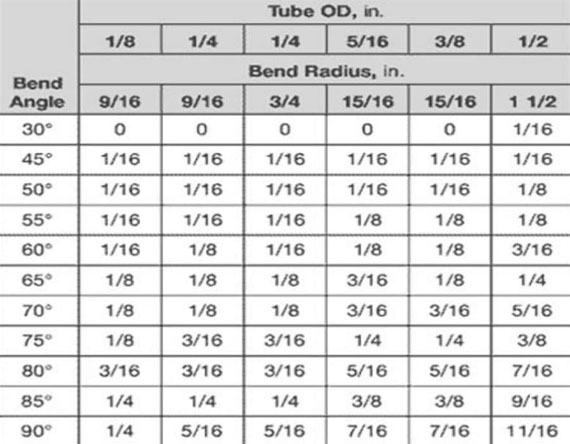
Standard Stretch Bend Radius: 2 x D
A standard stretch bend radius is typically expressed as 2 x D, where "D" represents the diameter of the tube. This is a commonly used ratio, particularly for stainless steel tubes that are intended for general applications. The 2 x D radius offers a balanced approach, allowing for a smooth bend without introducing excessive stress on the material.
This standard radius is a good starting point for most applications, as it provides sufficient room for the tube to bend without risking permanent deformation or breaking. However, it’s important to note that this value can vary based on the specific material grade and thickness of the tube, as well as the bending technique used. CNC bending and mandrel bending techniques can often accommodate this radius effectively, ensuring that the stainless steel tube maintains its structural integrity.
Minimum Bend Radius: 7 x D
The minimum bend radius is usually expressed as 7 x D and refers to the tightest bend radius that a stainless steel tube can achieve without damaging the material. This is a conservative radius that ensures the material won’t experience excessive strain or internal stress during the bending process. The 7 x D minimum is especially critical when working with thicker stainless steel tubes or those with a higher yield strength, as attempting a tighter bend could result in cracks, tears, or an altered material structure.
The 7 x D radius is often the recommended limit for stainless steel tube bending in industrial applications. When bending stainless steel pipes with high-strength alloys or larger diameters, it is crucial to ensure that the bending process stays within this radius to avoid material failure.
Key Takeaways:
By following these standard bending radius guidelines, manufacturers can ensure that stainless steel tube bending is done correctly, maintaining the material’s strength and reliability. If you are working with stainless steel CNC machining services or need CNC prototype machining for bending applications, these radius standards will guide the selection of appropriate tooling and bending methods.
Feel free to continue reading to learn more about the applications and considerations for stainless steel tube bending!
Stainless steel tubes are widely used across various industries due to their excellent durability, corrosion resistance, and versatility. The strength and flexibility of stainless steel make it the preferred choice for many high-performance applications. Here are some of the key industries where stainless steel tubes play a crucial role:
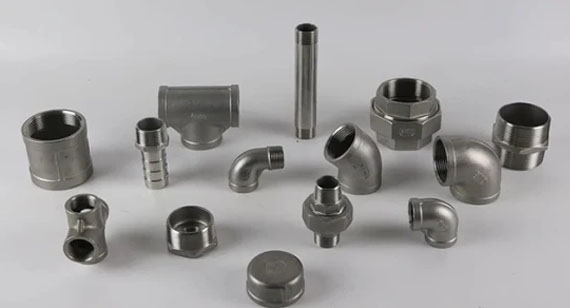
Aerospace
In the aerospace industry, stainless steel tubes are used in a variety of applications, from fuel and hydraulic lines to airframe structures. The material’s resistance to corrosion and high strength-to-weight ratio makes it ideal for aircraft manufacturing. Stainless steel tubes can withstand the extreme conditions encountered during flight, such as temperature fluctuations and exposure to high-pressure environments. They are also used in engine components, heat exchangers, and exhaust systems, ensuring safety and reliability in critical systems.
In the automotive industry, stainless steel tubes are commonly used for exhaust systems, fuel lines, and structural components. Stainless steel's corrosion resistance helps extend the lifespan of these parts, especially in vehicles exposed to harsh weather conditions or corrosive environments. Additionally, stainless steel tubes are lightweight yet strong, making them suitable for high-performance automotive applications. With the increasing focus on vehicle safety and efficiency, stainless steel tubes play a vital role in modern automotive design and manufacturing.
Technology
The technology sector relies heavily on stainless steel tubes for various applications, including cooling systems for electronics, medical devices, and semiconductor manufacturing. Stainless steel tubes help dissipate heat effectively, ensuring that electronic components remain cool and functional. The material is also used in cleanroom environments, where corrosion resistance is essential for maintaining the integrity of sensitive equipment. As technology continues to advance, stainless steel tubes are integral to ensuring the longevity and performance of high-tech products.
In the electrical industry, stainless steel tubes are utilized for wiring conduits, cable protection, and grounding applications. The material’s non-corrosive properties ensure that electrical systems remain operational over long periods, even in challenging environments. Stainless steel tubes are commonly found in underground electrical systems, providing protection against physical damage and exposure to elements like moisture and chemicals. Additionally, they are used in renewable energy projects, such as solar power installations, due to their ability to withstand harsh environmental conditions.
Construction
The construction industry uses stainless steel tubes for structural support, plumbing, and HVAC systems. Stainless steel’s strength, corrosion resistance, and aesthetic appeal make it an ideal material for both functional and decorative applications. In buildings and bridges, stainless steel tubes are often used for reinforcing structures, offering durability and resistance to environmental stress. Additionally, they are used in piping systems, where the need for corrosion resistance is paramount, especially in environments exposed to water, chemicals, or extreme temperatures.
Food and Beverage
In the food and beverage industry, stainless steel tubes are essential for piping systems, including those used in the transport of liquids, gases, and other materials. The material’s hygienic properties, ease of cleaning, and resistance to corrosion make it ideal for use in food processing, brewing, dairy, and other manufacturing facilities. Stainless steel tubes ensure that the products remain uncontaminated, adhering to strict food safety standards. They are also used in refrigeration systems and in the production of equipment such as mixers, pumps, and heat exchangers.
Conclusion
Stainless steel tubes are integral to many industries, providing strength, durability, and resistance to corrosion in a variety of applications. From aerospace to food and beverage, stainless steel's versatility ensures its continued importance across diverse sectors. Whether you need stainless steel tubes for CNC machining services, CNC prototype machining, or industrial applications, the material's properties make it an excellent choice for any project requiring reliability and performance.
If you're exploring stainless steel tube options for your next project, consider how these industries leverage this material to enhance product performance and safety.
When it comes to steel tube bending, the material's versatility makes it an excellent choice for many industries. However, whether it is the right option for your specific application depends on various factors such as material type, project requirements, and the desired outcome. Understanding these elements will help you make the best decision for your project.
Consider the Material Type
The first consideration is the type of steel you are working with. Stainless steel, for instance, is one of the most commonly bent materials due to its strength and corrosion resistance. However, carbon steel or alloy steel tubes may be better suited for applications requiring high strength and durability. The material's hardness and ductility impact how easily the tube can be bent, so it's crucial to choose the right material for the job.
Project Requirements and Design Specifications
Your project’s specific requirements will also play a vital role in determining whether tube bending is right for you. If your design calls for complex shapes or tight radius bends, tube bending can be an efficient and effective method. However, it is important to consider whether the radius, wall thickness, and bend angle are within the acceptable limits for the material and the bending process you choose.
For instance, when working with stainless steel tubes, the bend radius is a critical factor. Stainless steel typically requires a minimum bend radius, often expressed as a multiple of the tube diameter, to avoid damage to the material. If your design exceeds these limits, the tube may crack or become deformed during the bending process.
The Advantages of Tube Bending
Tube bending offers several benefits, including the ability to create custom shapes and angles without compromising the material’s integrity. Additionally, bending eliminates the need for welding, which can be time-consuming and expensive. Mandrel bending, CNC bending, and other advanced techniques also allow for precise control over the bend radius and angle, ensuring that the final product meets tight tolerances.
Key Considerations for Your Application
Here are some key questions to ask when determining if steel tube bending is suitable for your application:
Conclusion
Steel tube bending can be an ideal solution for various applications, offering high precision and flexibility in design. If your project requires custom shapes, tight tolerances, or specific material properties like stainless steel, tube bending is likely a great option. However, it's essential to consider factors such as material type, bend radius, and the specific requirements of your application to ensure the process is the right fit. By working with a professional CNC machining service, you can achieve high-quality results that meet both functional and aesthetic needs for your project.
If you're unsure whether steel tube bending is suitable for your application, consult with experts in CNC machining and CNC prototype machining. They can guide you through the process and help you achieve optimal results for your project.
How hard is it to bend stainless steel tube?
Bending stainless steel tubes can be challenging due to the material’s high strength and resistance to deformation. The difficulty depends on factors like the tube’s wall thickness, diameter, and the bending method used. Thin-walled stainless steel tubes are easier to bend than thicker ones, but all stainless steel requires careful control of the bending process to avoid cracking or warping.
Is mandrel tube bending better than roll bending?
Mandrel tube bending is often considered superior to roll bending for precise, tight-radius bends. In mandrel bending, a mandrel is inserted inside the tube, preventing it from collapsing or kinking during the bending process. Roll bending, on the other hand, is more suitable for less complex bends and does not provide the same level of precision or material protection.
What are the applications for stainless steel tube?
Stainless steel tubes are used in a variety of industries, including aerospace, automotive, construction, food and beverage, and electrical industries. Their strength, corrosion resistance, and aesthetic appeal make them ideal for high-performance applications such as exhaust systems, structural components, and sanitary piping.
Can stainless steel tube be bent without using special tools?
While it is technically possible to bend stainless steel without specialized tools, using tools like a mandrel, CNC bending machine, or press brake ensures more accurate, cleaner bends and reduces the risk of material damage. Special tools provide better control over the bending process, resulting in a higher-quality product.
How to prevent the pipe from collapsing during the bending process?
To prevent the collapse of the stainless steel tube during bending, it's important to use techniques such as mandrel bending, which supports the inside of the tube during the bend. Additionally, controlling factors such as the bending radius, speed, and pressure can reduce the likelihood of collapse. Proper preparation, including pre-heating the tube if necessary, can also help minimize collapse.
Can all grades of stainless steel be bent the same way?
No, different grades of stainless steel have varying levels of hardness, flexibility, and resistance to bending. For example, 304 stainless steel, a more common grade, is more malleable than 316 stainless steel, which is harder and more resistant to corrosion. When selecting a grade for tube bending, it’s crucial to consider the material’s properties to ensure it can be bent without failure.
Can stainless steel tube be bent?
Yes, stainless steel tube can be bent using several techniques such as mandrel bending, CNC bending, or roll bending. However, the bending process must be carefully controlled to avoid issues like cracking or distortion, particularly with thicker or harder stainless steel tubes.
How to easily bend stainless steel?
To easily bend stainless steel, ensure that you are using the appropriate bending equipment and that the tube is heated if necessary. The use of a mandrel during the bending process will also help avoid kinking or collapsing. Additionally, bending stainless steel at an appropriate speed and ensuring that the bending radius is within specifications will improve results.
Can you bend stainless steel without breaking it?
Yes, you can bend stainless steel without breaking it, but it requires careful attention to the tube's wall thickness, bend radius, and the amount of force applied. Using the right tools and techniques like mandrel bending or CNC bending reduces the risk of breakage and ensures a smooth, clean bend.
Do you need to heat stainless steel to bend it?
Heating stainless steel before bending can help make the material more ductile, allowing it to bend more easily without cracking. However, heating is not always necessary and depends on the type of stainless steel and the bending method used. In some cases, cold bending is possible without significant risk of damage.
Is it better to bend steel cold or hot?
Whether it is better to bend steel cold or hot depends on the material, the desired bend radius, and the application. Cold bending is ideal for thinner materials or when high precision is required, while hot bending is more suitable for thicker materials that are difficult to bend at room temperature. Generally, hot bending requires heating the steel to around 1,100°F to 1,300°F (593°C to 704°C) to soften it for easier shaping.
Will high temperatures damage stainless steel?
High temperatures can affect stainless steel’s properties, including its strength and corrosion resistance. Overheating can lead to warping, surface discoloration, or a reduction in its overall mechanical strength. Therefore, controlling the temperature is essential to ensure that the steel remains structurally sound.
Will stainless steel crack when heated?
Stainless steel can crack when heated if the temperature exceeds certain limits or if there is improper cooling. Overheating can lead to thermal stress, which may cause the material to become brittle and crack. It’s important to carefully control the temperature and cooling rate when heating stainless steel.
What temperature will damage stainless steel?
Temperatures over 1,300°F (704°C) may cause stainless steel to lose some of its desirable properties. The exact temperature threshold for damage can depend on the specific grade of stainless steel. For example, some high-carbon stainless steels may start to degrade at lower temperatures than their lower-carbon counterparts.
Will stainless steel deform when heated?
Yes, stainless steel can deform when heated, especially if subjected to temperatures higher than its recommended limits. High heat can cause the material to soften, which may result in warping, bending, or dimensional changes. Proper heat treatment and temperature control are crucial to preventing unwanted deformations.
How to prevent stainless steel from warping?
To prevent stainless steel from warping during the bending process, ensure that the material is evenly heated, and use proper tooling such as a mandrel or CNC bending machine. Additionally, controlling the bending radius and applying gradual force during bending will reduce the likelihood of warping.
Will stainless steel soften when heated?
Yes, stainless steel softens when heated. The material becomes more ductile at higher temperatures, making it easier to bend or form. However, excessive heating can weaken the steel, so it’s important to maintain optimal temperatures for the specific grade of stainless steel being used.
Does heating stainless steel produce magnetism?
Heating stainless steel can affect its magnetic properties, but this depends on the specific grade of stainless steel. Austenitic stainless steels (such as 304 and 316) are typically non-magnetic, while ferritic and martensitic stainless steels are magnetic. Heating can change the crystal structure of these materials, potentially affecting their magnetism.
These FAQs are designed to help you better understand the complexities of stainless steel tube bending and offer solutions to common challenges. Whether you're working with CNC prototype machining, CNC machining services, or simply seeking advice on bending stainless steel pipe, following the right practices and techniques will ensure the best possible results for your project.
